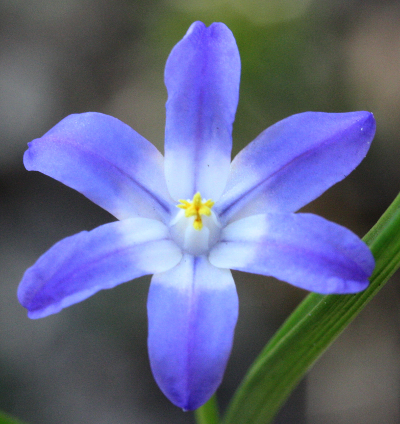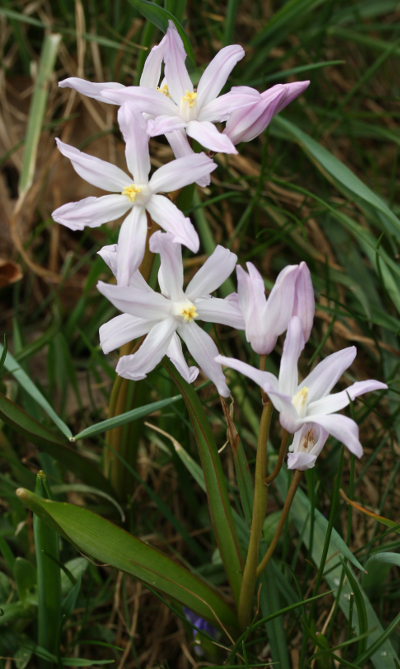Siehe's glory-of-the-snow |


The flowers of Siehe's glory-of-the-snow (Scilla siehei) are mostly blue with a white center, below the variety 'Pink Giant'
| Scilla siehei Stapf: | |
| Blooming period: | February–April |
| Height: | approx. 10 cm |
| Flowers: | bisexual, actinomorphic, mostly blue with white center, conspicuous, Ø up to 30 mm, stamens: 6, styles: 1 |
| Tepals: | 6, inner half white. outer half mostly blue |
| Leaves: | 2, basal, parallel-veined |
Plant
perennial, herbaceous with an Plant perennial, herbaceous, with
an approximately 3 cm thick bulb, surrounded by a brown tunic.
Stems
upright, incl. flower scape about 10 cm high
Leaves
2, basal, 20 mm wide, about as long as the stalk.
The
stalks bears a single stalked flower or it has a terminal, a few cm
long flower scape, with 2–3 mostly nodding flowers. Pedicels at the
base with a very small bract.
The up to 25 mm
wide, flat
disk-shaped flowers possess int the center of the flower a sometimes
vaguely recognizable or blurred delineated white "eye".
The
6 identically looking tepals are fused urn-shaped at the base and so
narrow that they do not overlap at the base or just a little bit.
At
the top of the corolla tube arise 6 incurved stamens with yellow
anthers, whose filaments are widened and cover the ovary.
After
insect pollination (bees, bumblebees, wasps) are formed from the
superior ovary 3-part, many-seeded, rounded capsule fruits.
The
seeds have a nutrient-rich appendage (elaiosome) and are spread by
ants. Propagation also by formation of daughter bulbs. Plants
poisonous, especially the bulbs!
Scilla siehei ×
luciliae is a naturally arising bastard of Scilla siehei and
S. luciliae.up to 3 cm thick bulb.
Stems upright to curved, incl. flower scape about 10 cm high.
Leaves 2, basal, about 20 mm wide, and 12 cm long, with a hooded tip.
The stem bears a terminal, slightly orange flower scape with 4–12 upright flowers. They sprout horizontally in the middle of the flower scape, while the lower ones are slightly nodding. Pedicels up to 35 mm long, at the base with a very short bract.
The up to 30 mm wide flowers are actinomorphic and mostly blue with a white center, which occupies half of the flower.
The 6 tepals are fused urn-shaped at the base.
At the top of the corolla tube arise 6 incurved stamens with yellow anthers, whose white filaments are widened and cover the ovary.
After insect pollination (bees, bumblebees, wasps) are formed from the superior ovary 3-piece, many-seeded, rounded capsule fruits.
The seeds have a nutrient-rich appendage (elaiosome) and are spread by ants. Propagation also by formation of daughter bulbs. Plants poisonous, especially the bulbs!
Scilla siehei may hybridize with Scilla luciliae (Scilla siehei × luciliae).
Scilla siehei in garden centers is called Chionodoxa forbesii.
| Floral formula: |
| * [P(3+3) A3+3] G(3) superior |
Occurrence:
Roadsides,
parks, public gardens, often near human settlements. Prefers moist,
nutrient-rich, sandy soil and sunny sites.
Distribution:
Originally
western Turkey. In Central Europe garden escape.